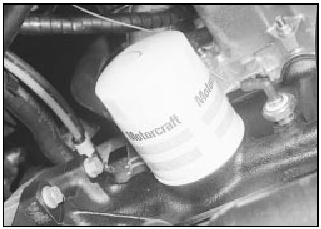Engine oil and filter renewal (Every 6000 miles or 6 months)
1 Frequent oil and filter changes are the most important preventative maintenance procedures that can be undertaken by the DIY owner. As engine oil ages, it becomes diluted and contaminated, which leads to premature engine wear.
2 Before starting this procedure, gather together all the necessary tools and materials.
Also make sure that you have plenty of clean rags and newspapers handy to mop up any spills. Ideally, the engine oil should be warm, as it will drain better and more built-up sludge will be removed with it. Take care, however, not to touch the exhaust or any other hot parts of the engine when working under the vehicle. To avoid any possibility of scalding, and to protect yourself from possible skin irritants and other harmful contaminants in used engine oils, it is advisable to wear rubber gloves when carrying out this work. Access to the underside of the vehicle will be greatly improved if it can be raised on a lift, driven onto ramps or jacked up and supported on axle stands (see “Jacking and Vehicle Support”). Whichever method is chosen, make sure that the vehicle remains as level as possible, to enable the oil to drain fully.
3 Remove the oil filler cap from the rocker cover, then position a container beneath the sump.
4 Clean the drain plug and the area around it, then slacken it using a suitable socket or spanner (see illustration). If possible, try to keep the plug pressed into the sump while unscrewing it by hand the last couple of turns.
As the plug releases from the threads, move it away sharply so the stream of oil issuing from the sump runs into the container, not up your sleeve!

6.4 Engine oil drain plug (arrowed) - CVH engine
5 Allow some time for the old oil to drain, noting that it may be necessary to reposition the container as the oil flow slows to a trickle.
6 After all the oil has drained, wipe off the drain plug with a clean rag and check the condition of the sealing washer. Renew the washer if necessary. Clean the area around the drain plug opening, then refit and tighten the plug to the specified torque setting.
7 Move the container into position under the oil filter. The oil filter is located at the rear of the cylinder block, and is accessible from under the vehicle (see illustration)

6.7 Oil filter location - CVH engine
8 Using an oil filter removal tool, slacken the filter initially. Loosely wrap some rags around the oil filter, then unscrew it and immediately position it with its open end uppermost to prevent further spillage of oil. Remove the oil filter from the engine compartment and empty the oil into the container.
9 Use a clean rag to remove all oil, dirt and sludge from the filter sealing area on the engine. Check the old filter to make sure that the rubber sealing ring hasn’t stuck to the engine. If it has, carefully remove it.
10 Apply a light coating of clean oil to the sealing ring on the new filter, then screw it into position on the engine. Tighten the filter firmly by hand only - do not use any tools. Wipe clean the exterior of the oil filter.
11 Remove the old oil and all tools from under the vehicle, then (if applicable) lower the vehicle to the ground.
12 Fill the engine with the specified quantity and grade of oil, as described in “Weekly checks”. Pour the oil in slowly, otherwise it may overflow from the top of the rocker cover.
Check that the oil level is up to the correct level on the dipstick, then refit and tighten the oil filler cap.
13 Run the engine for a few minutes, and check that there are no leaks around the oil filter seal and the sump drain plug.
14 Switch off the engine and wait a few minutes for the oil to settle in the sump once more. With the new oil circulated and the filter now completely full, recheck the level on the dipstick and add more oil if necessary.
15 Dispose of the used engine oil safely with reference to “General repair procedures” in the Reference Sections at the end of this manual.
See also:
Coil - testing, removal and refitting
Testing
All models except 1.6 and 1.8 litre
CVH (R6A type)
1 The coil is located on the left-hand side of
the engine compartment and is retained by a
metal strap (see illustration). It is of high ...
Tailgate (Hatchback and Estate models) - removal and refitting
Note: On Hatchback models made before
1990 with an integral heated rear
window/radio aerial, note that the radio aerial
lead is routed through different openings to
that of other models in the rea ...
Fluid leak check (Every 6000 miles (10 000 km) or 6 months)
1 Visually inspect the engine joint faces,
gaskets and seals for any signs of water or oil
leaks. Pay particular attention to the areas
around the rocker cover, cylinder head, oil
filter and sump ...
